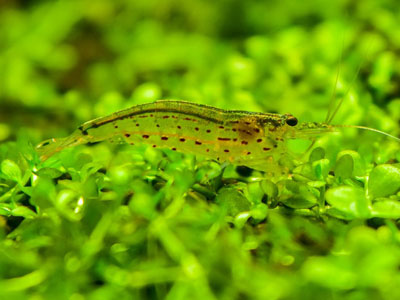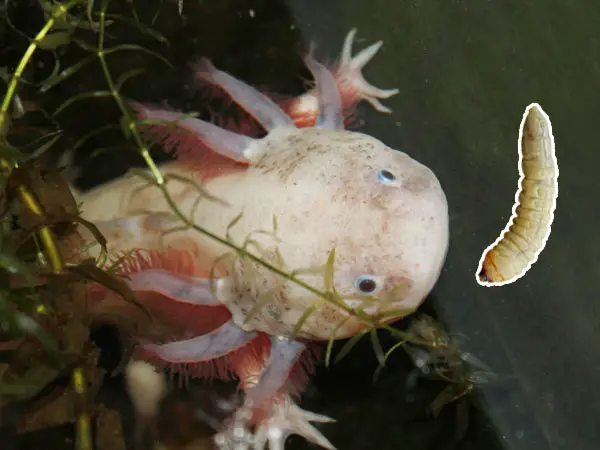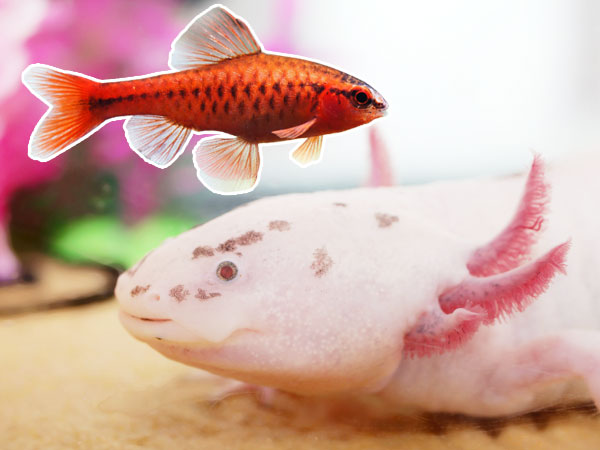
If you’re wondering whether your pet axolotl needs any tank mates, you’re off the hook – axolotls don’t need any tank mates, in fact, they do best when they’re kept alone.
But don’t they get sad? Wouldn’t some company be beneficial to them? Surprisingly, no. On the contrary, having tank mates may offer more downsides to your axolotls than benefits.
In fact, any benefits that may arise from your axies having company are only marginal and not worth the trouble.
Axolotls aren’t community creatures; they don’t require to be kept with other axolotls or other aquatic species and do very well on their own.
Unlike some fish species or other aquatic animals, axolotls thrive if kept in isolation. That’s because they have very specific keeping requirements that are best met in the absence of other tank residents.
In this article, I’m going to cover some of the tank mates that you could possibly keep with axolotls, however, in all honesty, I strongly advise against a mixed species aquarium when it comes to axolotl.
Can Axolotls Live with Fish?
Putting aside the fact that axolotls are indifferent to having tank mates, there’s another important question — can axolotls live with fish or other freshwater creatures like snails and shrimp?
Technically, yes, they can. But it’s not advisable to have other residents in the aquarium with axolotls. There are multiple reasons to why tank mates just don’t work for axolotls.
Below I will explain some of the chief reasons why axolotls and tank mates don’t work:
Injuries & Infections
Fin-nipping fish will nip the gills of axolotls, which may not be such a problem in and of itself since axolotls can and do successfully regenerate gills and other body parts, but the secondary infections caused by such injuries can be fatal, especially if opportunistic parasites get into the water.
However, nipping and injuries may not even be the biggest threat faced by axolotls. There’s another issue that’s related to their diet and the way axolotls eat.
Impaction
Axolotls are carnivores and they’ll try to eat any fish or small crustaceans that they can swallow whole. This means that you can basically give up any hopes of small fish cohabiting peacefully with your axolotls. They’ll just end up getting devoured by your axie one by one.
Axolotls will not play nice and they will certainly not ignore the tasty treat these small fish or small crustaceans represent for them.
Even if they can’t swallow them whole, they may still have a go at them, which brings us to another set of problems like choking or impaction.
The problem is that if the fish or other tank mate is not small enough to fit into their mouth, there’s a high risk of the axolotl still trying to swallow the fish, but only managing to swallow them halfway.
Axolotls can choke on food that is too large to pass normally down their GI tract or food can get stuck at an angle that won’t allow its expulsion, leading to impaction, which can be fatal for your axolotls.
With these in mind, you can weigh the pros and cons of keeping any tank buddies with your axolotl.
If you do decide to ignore the warnings and try your luck anyway, I would recommend the following axolotl tank mates that could work out for your tank if you take extra precautions and measures.
Potentially Suitable Axolotl Tank Mates
When it comes to choosing tank mates for your axolotl, there are some very bad options and some not-so-bad options. Some owners report not having any issues keeping their axolotl with the tank mates listed below, other report that it’s only a matter of time until their axies get a taste of their tank buddies.
I’m not saying that none of the options below will work out for you, but the chances are usually low. Still, if you’re going to try your luck, you may increase your chances with the following tank mates:
1. Other Axolotls

If you’re hell bent on getting a tank buddy for your axolotl, another axolotl would be your best pick. There are, however, a few caveats with this pairing too.
Juvenile axolotls can display cannibalistic tendencies towards each other (eating each other’s gills, limbs, etc.). In adulthood, this tendency is not so pronounced, so you may not experience such issues with two adult axolotls.
Except if one axolotl is bigger than the other, then nipping may happen since the bigger axolotls will bully the smaller one.
Here too, injuries may not even be the primary problem, but the potential for secondary infections increases. Plus, the smaller axolotl will become stressed and will have a weakened immune system. As a result, you may want to separate axolotls that don’t get along with each other.
Having a large tank with lots of hiding spots, where the smaller axolotl can seek cover can also help, but if bullying and nipping is still happening, the safest option is separation.
You can keep axolotls of the same gender or you can set up a mixed gender tank but be advised that axolotls can successfully reproduce in captivity and that the female axolotl can produce up to 1000 eggs at a time. If you’re not ready for that sort of challenge, maybe keep only same gender axolotls.
2. Small Shrimp

Amano shrimp or ghost/glass shrimp can be a beneficial addition to any freshwater tank. That’s because these bottom feeders scavenge the substrate for food and do an excellent job at cleaning up leftover food. This in turn will help keep the water clean in your axolotl tank.
The problem? For axolotls, shrimp are right up their alley and make quite the delicious and nutritious food.
Because ghost shrimp have a nearly transparent body, they can do a great job at hiding in the tank, especially if there are plants in the tank, but since axolotls have a good sense of smell, they can track them down if they want to.
Now, even if your axies end up eating these small shrimps, they’re safe since Amano shrimp are small enough to be swallowed without the risk of impaction. In fact, some owners even offer shrimp to their axolotls as an occasional snack.
Still, if you don’t want to feed your axolotl shrimp delicacies, it’s best to avoid keeping them in the same tank.
Plus, shrimp can carry diseases, so you may want to hold off adding shrimp to the axolotl tank until you’re sure they carry no diseases (keep them separated for 30 days to make sure the shrimp is disease-free).
3. Minnows

White Cloud Mountain Minnows are small, peaceful fish that can do well in the cold water that axolotls also enjoy.
Because of their lack of sharp spines or exoskeleton, they may not pose a health threat even if swallowed by your axies. But even though minnows are not a threat to axolotls, axolotls are a threat to them.
Since there’s no guarantee your lotls won’t make a tasty snack out of these beautiful fish, perhaps it’s best to enjoy them in separate tanks, where they are both better off.
4. Guppy Fish

Generally small and with no hard exoskeletons, guppies can potentially coexist with axolotls, provided that axies won’t take a culinary interest in them.
Still, I don’t recommend keeping them in the same tank because guppies can breed fast and in large numbers, which may sound like they’d be a good food source for axolotls, axolotls will become stressed out by their large numbers.
You should also avoid keeping guppies with juvenile axolotls, because they can cause impaction if guppies are not small enough to normally pass through the GI tract of axolotls.
Larger guppies can nip the gills of axies plus guppies can carry diseases and even parasites that can infect axolotls if the fish weren’t quarantined prior to their introduction to the aquarium.
5. Mini Snails

I wouldn’t keep snails with my axolotls, but I have heard of some small snail varieties that do have a softer exoskeleton and could work out if kept in a tank with axolotls.
Baby cold water snails like apple snails, ramshorn snails, bladder snails are potentially safe options for adult axolotls, however, the risk of their exoskeleton breaking and causing damage in the gut lining of your axolotl shouldn’t be dismissed.
Because snails are bottom feeders, they are beneficial for the aquarium environment cleaning up leftover food particles and helping in keeping the aquarium substrate clean.
Still, it’s best if you don’t rely only on bottom feeders to pick up leftover food and continue your tank maintenance tasks as before.
Food that is left in the tank to rot cause ammonia spikes, which can be sudden and unexpected, so it’s safer to get ahead of the problem.
As soon as snails start growing bigger (especially apple snails), you should remove them because they become a choking hazard for your lotl.
Snails can also breed quickly and their numbers can get out of control, so it’s best to keep only a few, otherwise you may find it very difficult to remove them once they breed.
LIke fish and shrimp, snails can also carry diseases, so it’s best to quarantine them before you put them in together with your axolotl.
The Takeaway…
Some of the options I presented above could work out for you, but you should always keep in mind the risks associated with these axolotl tank mates and do your best to prevent injuries from happening.
Monitor the tank for any problems and separate tank mates that are injuring your axolotl or that are a potential health threat.
Tank Mates You Should AVOID Keeping with Axolotls
While the axolotl tank mates I discussed above weren’t completely risk-free choices, the options that I’m going to discuss below are an even bigger threat and you should never keep them with axolotls:
1. Goldfish
You may think that because they like colder water, goldfish may be a good choice for a tank buddy. Wrong. Goldfish start out small, but grow to up to 12 inches, which means they’ll get as big as an adult axolotl.
While they’re still small, axolotls will try to feed on them, which can lead to choking and impaction.
Goldfish large enough will nibble at the gills and fins of axolotls, which will leave them injured and stressed out.
Another reason why I strongly disagree with anyone who claims that goldfish and axolotls can work in the same aquarium is that goldfish produce a lot of waste, which added on top of the high bio-load of axolotls spells nothing but trouble for the water chemistry in the tank.
2. Cory Catfish
Yes, they’re small, which may mistakenly lead axolotl owners to believe that they can be a good choice for a tank mate. Unfortunately, cory catfish are very dangerous for axolotls.
The danger of cory catfish lies in their defensive spines on their pectoral and dorsal fins. An axolotl attempting to swallow a cory catfish may end up with puncture wounds that could cause infection or even death.
3. Otocinclus Catfish
As small fish, otocinclus catfish seem like a safe choice for axies. Otocinclus catfish are dangerous for axolotls for the same reasons that cory catfish don’t make a safe choice for them. They too have defensive spines that can injure axolotl.
Conclusion
You can raise your axolotls without any tank buddies, and they’ll be better off. You won’t have to worry about them swallowing fish and other crustaceans and possibly ending up dying because of an obstruction.
Also you don’t have to worry about making changes to the temperature and other water parameters to accommodate the needs of other tank residents.
To raise a healthy axolotl, I recommend focusing on their needs primarily, and avoid keeping them together with other freshwater creatures that simply won’t make it long around axolotls.
If you don’t believe your axolotl does well on its own and you’re adamant on it having a tank mate, your first choice should always be another axolotl.




